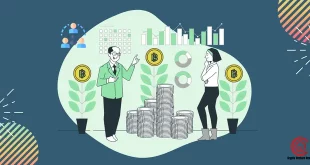Bitcoin is a hot topic on social media and other industries for several factors. Apart from the increasing price of Bitcoin and big investments in the market that are made by some of the most prominent figures in the world, this popular digital currency makes headlines for another factor that is known as Bitcoin halving. But what exactly is this halving and how does it operate?
What Is Bitcoin Halving?
This is also known as Bitcoin halvening and is one of the most awaited events in the crypto space. To make you understand better let us have a quick look at the process involved in acquiring today’s leading crypto coin. Bitcoin mining is the process where the miners obtain BTC through digging into the digital cave of Bitcoin with special mining equipment as their digital pickaxe.
Bitcoin miners are required to solve the most complex mathematical equation of the network to complete “blocks” that are added to the blockchain of the Bitcoin. A block means a file that keeps or stores 1 megabyte (MB) worth of BTC transactions. As more and more verification of the transactions are done, the network of Bitcoin also increases in size.
After these puzzles are solved successfully verifying the transactions, which usually requires 10 minutes, miners will get Bitcoins as their rewards. Now with the process of Bitcoin halving, the rewards that the miners have earned decrease by half after a set of 210,000 blocks is a miner or this takes place approximately after every 4 years. This cuts in half the rate at which new BTCs are released into circulation. This is the way with which Bitcoin uses synthetic inflation that Bitcoin halves every 4 years until all the BTCs are released into circulation.
This process will continue until around the year 2140. At that point in time, miners will be awarded with fees for processing transactions, which will be paid by the network users. These fees make sure that the miners still have the incentive to mine and do not let the network stop. The idea behind this is that competition for these fees will allow them to remain low after they have finished halving.
The halving process is important because it marks another drop in the rate of the latest BTC being produced as it reaches its finite supply. As of 2021 October, there are nearly 18.85 million BTCs already in circulation, leaving just nearly 2.15 million left to be released through mining rewards.
What Happens When Bitcoin Halves?
The term “halving” as it signifies Bitcoin to do with how many Bitcoin tokens are there in a newly formed block. Back in 2009, when Bitcoin was released, each block had 50 BTC, but this amount was set to be decreased by 50% approximately every four years. Today, there have been 3 events of halving, and a block now only has 6.25 BTC. When the next halving happens, a block will only have 3.125 BTC.
When Have the Halvings Occurred?
Here is a Bitcoin halving date history. The first Bitcoin halving 2012 took place on Nov. 28, after a complete 10,500,000 BTC had been successfully mined. The next took place on July 9, 2016, and the last was on May 11, 2020. The next is predicted to take place in early 2024 (Bitcoin Halving 2021). So there will be no Bitcoin halving 2021.
Now you may wonder why are the halvings occurring less than every four years? The algorithm of Bitcoin mining is set with an aim of finding the latest blocks once in every 10 minutes. However, if more miners take part in the network and add more hashing power, the time to find blocks will reduce. This is corrected by rebooting the mining difficulty once every 2 weeks or so to gain a 10-minute target. As the BTC network has evolved to a great extent over the past decade, the approximate time to find a block has continuously remained less than 10 minutes (roughly 9.5 minutes).
What Happens When All Blocks Have Been Mined?
Approximately around 2140, the last of the 21 million BTCs ever to be mined will have been mined. At this point in time, the halving program will discontinue because there will be no more new BTCs left to be mined. Miners, however, will still be offered incentives to continue confirming and validating the latest transactions on the blockchain as the value of transaction fees that are paid to miners is predicted to increase into the future, the reasons being that a greater transaction amounts that have fees will be involved, along with that bitcoins will have a greater nominal value in the market.
The Bottom Line
From the things that we have discussed earlier, we have learned that Bitcoin halving has different effects for its market value, traders, miners, and investors. It has its fair share of both advantages and disadvantages. Like other assets and valuable products, the price of Bitcoin comes down to demand and supply. However, for miners who get a diminishing amount of rewards approximately every four years, it might not always be as inspiring and enticing as the reward of 50 Bitcoin per block that they can earn in the pre-halving era.
Frequently Asked Questions On Bitcoin Halving
1. Will bitcoin halving increase price?
After every halving, bitcoin encounters a bull run. As supply falls spurring the demand, the price increases. However, this upsurge is not immediate.
2. What happens to bitcoin during halving?
Bitcoin miners are required to solve the most complex mathematical equation of the network to complete “blocks” that are added to the blockchain of the Bitcoin. A block means a file that keeps or stores 1 megabyte (MB) worth of BTC transactions. As more and more verification of the transactions is done, the network of Bitcoin also increases in size.
3. What is the smallest unit of Bitcoin called?
Every smallest unit of Bitcoin is known as Satoshi.
- The Bitcoin Wallet Boom: Why Demand Is Skyrocketing - 25/11/2023
- How To Choose The Best Crypto Exchange Affiliate Programs - 03/03/2023
- Crypto License: How To Get It Now? - 03/02/2023
 Crypto Venture News One stop Crypto Track Down
Crypto Venture News One stop Crypto Track Down 






